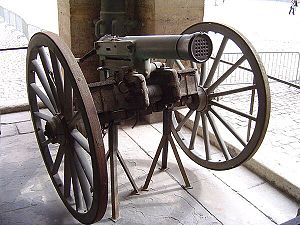
Back Mitralyoz Azerbaijani Митральоза Bulgarian Mitrailleuse de Reffye Czech Mitrailleuse German Metrallera Spanish Mitrailleuse Croatian ミトラィユーズ Japanese 미트라이외즈 Korean Mitrailleur Dutch Mitraljøse NN
| Mitrailleuse de Reffye a.k.a. "Canon a Balles" (1866) | |
|---|---|
 Reffye mitrailleuse Le Général Hanicque ("Canon à balles modèle 1866"), manufactured in 1867, on display in Les Invalides | |
| Type | Volley gun |
| Place of origin | France |
| Service history | |
| In service | 1866–1908 |
| Used by | France Mexico Kingdom of Dahomey Dominican Republic[1] |
| Wars | Franco-Prussian War Yaqui Wars United States occupation of the Dominican Republic (1916–1924) |
| Production history | |
| Designer | J.B. Verchere de Reffye |
| Designed | 1865 |
| Manufacturer | Meudon and Nantes government facilities |
| Produced | 1866–71 |
| No. built | About 400 |
| Specifications | |
| Mass | 340 kilograms (750 lb) with carriage: 855 kilograms (1,885 lb) |
| Length | 1.75 m |
| Shell | elongated shotgun shell configuration, center fire, 50-gram (770 grain) patched bullet |
| Caliber | 13 mm (.512 caliber) |
| Rate of fire | 125 rounds/minute |
| Effective firing range | 1,800 metres (2,000 yd) |
| Maximum firing range | 3,400 metres (3,700 yd) |
A mitrailleuse (French pronunciation: [mitʁajøz]; from French mitraille, "grapeshot") is a type of volley gun with barrels of rifle calibre that can fire either all rounds at once or in rapid succession. The earliest true mitrailleuse was invented in 1851 by Belgian Army captain Fafschamps, ten years before the advent of the Gatling gun. It was followed by the Belgian Montigny mitrailleuse in 1863. Then the French 25 barrel "Canon à Balles", better known as the Reffye mitrailleuse, was adopted in great secrecy in 1866. It became the first rapid-firing weapon deployed as standard equipment by any army in a major conflict when it was used during the Franco-Prussian War of 1870–71.
A steel block containing twenty-five 13 mm (.51 calibre) centre-fire cartridges was locked against the breech before firing. With the rotation of a crank, the 25 rounds were discharged in rapid succession. The sustainable firing rate of the Reffye mitrailleuse was 100 rounds per minute and its maximum range was about 2000 yards (1800 m), a distance that placed their batteries beyond the reach of Prussian Dreyse needle rifle fire. Reffye mitrailleuses were deployed in six gun batteries and were manned by gunners as a form of special artillery.
Although innovative and capable of good ballistic performance, the Reffye mitrailleuse was a tactical failure because its basic concept and operational use were flawed. Only 210 Reffye mitrailleuses were in existence at the beginning of the Franco-Prussian War in 1870. Their field use was discontinued by the French Army after 1871. After the Gatling gun was replaced in service by newer recoil- or gas-operated weapons, multi-barrelled weapons fell into disuse for many decades. Some examples were developed during the interwar years but only as prototypes or were rarely used. The word mitrailleuse became the generic term for a machine gun in the French language because of its early appearance in the field of weapons, although the mitrailleuse was manually operated.
© MMXXIII Rich X Search. We shall prevail. All rights reserved. Rich X Search